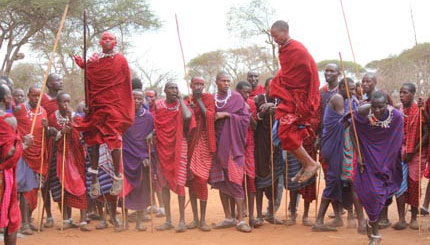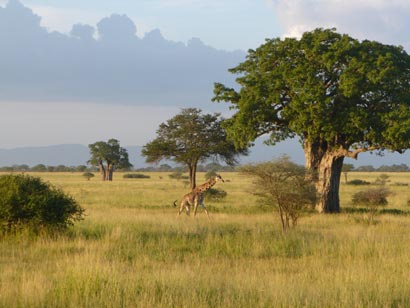Tanzania
Country statistics

Land area: 342,100 sq miles (886,039 sq km)
Total area: 364,898 sq miles (945,087 sq km)1
Population (2010 est.): 41,892,895 (growth rate: 2.0%); birth rate: 33.4/1000; infant mortality rate: 68.1/1000; life expectancy: 52.5; density per sq miles: 111
Capital City: Dodoma
Monetary unit: Tanzanian shilling
Languages: Swahili, English (both official); Arabic; many local languages
Ethnicity/race: mainland: native African 99% (includes 95% Bantu, consisting of well over 100 tribes), Asian, European, and Arab 1%; Zanzibar: Arab, native African, mixed
Religions: mainland: Christian 30%, Islam 35%, indigenous 35%; Zanzibar: more than 99% Islam
Country introduction

Tanzania is bordered on the south by Mozambique, Malawi, and Zambia; on the west by the Democratic Republic of the Congo, Burundi, and Rwanda; on the north by Uganda and Kenya; and on the east by the Indian Ocean. Tanzania is the largest of the East African nations, and it possesses a geography as mythic as it is spectacular.
Tanzania is a land of rolling plains, dramatic mountain ranges, great lakes and pristine white sandy beaches. From the snow-capped majesty of Kilimanjaro, the highest freestanding mountain on Earth, to the forested shores of Lake Tanganyika, the world's longest, second-deepest and least-polluted freshwater body, this is a land of astonishing scenic beauty.
Tanzania is also a compelling safari destination. In the south, is Selous, the world's largest game reserve, in the north, is the sweeping plains of the Serengeti, which are the most famous park in Africa, while nearby Ngorongoro Crater is the most scenically dramatic. The remote west is home to Africa's top chimpanzee tracking sites, namely Gombe Stream and Mahale Mountains. And while the eastern coastal belt is somewhat lacking in big game, compensation comes in the form of the forested Eastern Arc Mountains, home to dazzling diversity of birds, monkeys, chameleons and flowering plants found nowhere else in the world.
The culture

Tanzanian culture is a delightful mix of influences with over 120 tribes. Tanzania is one of the most culturally diverse countries in the world. From the tall graceful Maasai warriors, the ancient ways of the Hadza bushmen, the resourceful agricultural practices of the Wameru, the artistic talents of the Makonde to the Chaga farmers and traders. Each of the 120 different tribes in Tanzania have their own distinct ways of life but together, they gracefully unite to form Tanzania.
Tanzania culture has contributed a lot in the development and advancement of the country. The diversity of Tanzania culture appeals to a large number of people coming from distant areas across the globe. The various forms of Tanzania culture are language, painting, sculpture, national anthem, popular dance music and art.
The most important contribution towards the culture of Tanzania has been done by the language. More than 100 languages are spoken in this country. After the independence, the government of the country found it very difficult to administer. So it introduced Swahili language as the official language. The literature of Tanzania is no less enriched. Some eminent writers of Tanzanian literature are Shafi Adam Shafi, Chachage Seith Chachage, Amandina Lihamba, Edwin Semzaba,Penina Muhando Mlama and Euphrase Kezilahabi. "Mungu Ibariki Afrika" is the national Anthem of Tanzania, South Africa and Zimbabwe. The national Anthem helps in strengthening the unity among the people so that they can usher in an era of all round national development.
Makonde sculpture is quite famous in Tanzania and few noted Tanzanian painters are Stephen Ndebalema, Elias Jengo and Mohammad Raza. Among the painting styles, Tingatinga painting deserves mention. Bongoflava has represented the new genre of music in the country. Various music bands like Ottu and Sikinde are also much popular.
Attractions & landmarks

On the northern border of Tanzania is Mount Kilimanjaro National Park. Here visitors will find the tallest freestanding mountain in the world and Africa's tallest mountain at 5,895 m (19,341 ft) above sea level. Mountain climbers can join more than 25,000 people who make the attempt to reach the top every year. The best time to do this is in January to February and in September.
Tanzania is also home to the Serengeti National Park, where visitors can observe different animals in their natural habitat, including the yearly migration of zebra's and wildebeest stalked by predators. Game reserves on this African nation are abound, there is the Ngorongoro Conservation Area, the Selous Game Reserve, Ruaha National Park, to name a few. A careful blend of tourism and conservation exist at these parks.
Zanzibar would be an ideal destination for those who are looking for a beach destination. There are other attractions in addition to beaches on this archipelago on the Indian Ocean. Spices, raffia, and tourism are Zanzibar's main industries. Other attractions include the Peace Memorial Museum, the Old Fort, and the Maruhubi and Mtoni Palace Ruins.